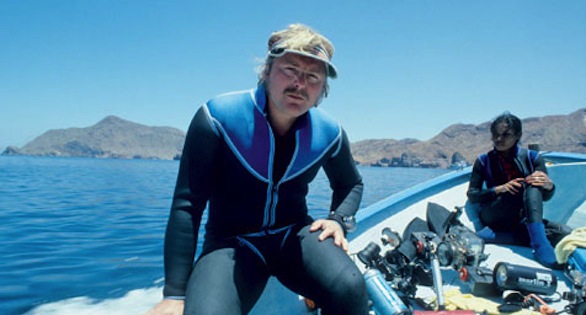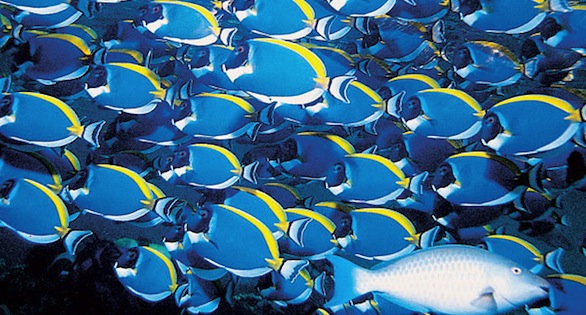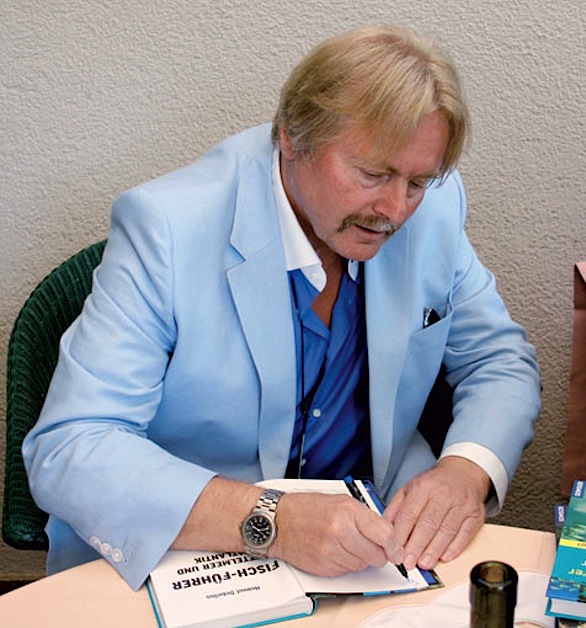Originally posted: May 2010
Excerpt from CORAL May/June 2010
By Daniel Knop
The name Helmut Debelius is a byword for reef fish and invertebrate enthusiasts, not only for divers but also among marine aquarists worldwide. The Fire Shrimp, Lysmata debelius, Debelius Reef Lobster, Enoplometopus debelius, the Blue Mauritius Dwarf Angelfish, Centropyge debelius, and the Softcoral Seahorse, Hippocampus debelius, as well as several other species, bear his name, and his books occupy the shelves of every serious marine student of coral reefs.
For 30 years his photographic archive, whose logo consists of the Indonesian word for fish, has made its mark on the underwater literature, and now the “father of fishes” is retiring from these activities—once and for all. This was reason enough for the CORAL team to give our readers a brief overview of the extraordinary life of this self-taught expert.
CORAL: Helmut, in your past 30 years as an underwater photographer you have spent many hours underwater with your camera. But nobody is born with a neoprene skin—so how did it all come about?
Helmut Debelius: My first tropical dive took place somewhat unexpectedly in 1974. A Singhalese lady with whom I was friendly asked me if I would drive her uncle to see his customers as I had a car. He was a collector of coral fishes and was flying in the next day from Colombo. Until then I had dived only on the Costa Brava and around the Canaries. Of course I already knew that a fish can swim, but the majority of fishes in this region were not very eye-catching, and I hadn’t yet considered underwater photography at all.
CORAL: That doesn’t sound particularly enthusiastic. So what happened after this first contact with tropical coral reefs to move you to make exploring and documenting them your life’s work?
Helmut Debelius: The colorful underwater world had already made a permanent impression on me. Rodney Jonklaas, the uncle of the aforementioned Singhalese lady, then took me on a tour of the fish wholesalers in the Rhine-Main region whom he supplied with coral fishes and, even then, with invertebrates.
My astonishment at the splendidly colored coral fishes grew and grew, I finally asked, “Where do these fantastic fishes live, then?” He replied, “Right on my doorstep.”. Just two weeks later I was there myself, in Negombo.
Rodney was pleased at my enthusiasm, and immediately took me with him in his outrigger and pressed his Nikon II, with no flash, into my hand. He liked to catch coral fishes in the mouth of a river on the west coast of Sri Lanka, and you can imagine what the visibility was like there. This is reflected in my first underwater photo, which nevertheless filled me with great pride. I had no other tropical diving grounds for comparison. The species diversity of the Indian Ocean on the west coast of Sri Lanka continued to fascinate me, and Rodney patiently answered all my novice questions.
Before long he asked me to help him collect fishes. And then something happened that amazed even him: during my very first collecting dive an uncommon species in Rodney’s domain, a gorgeous Blue-ring Angelfish (Pomacanthus annularis), small, but already fully-colored, flapped into my hand net. That evening I sat entranced in front of the Blue-ring Angelfish aquarium at his collecting station, and my fascination with this fish in turn had consequences for my future life. The Blue-ring Angelfish not only became my logo fish on my letterhead and books when I subsequently started my IKAN underwater archive, but later even adorned my new house in Frankfurt.
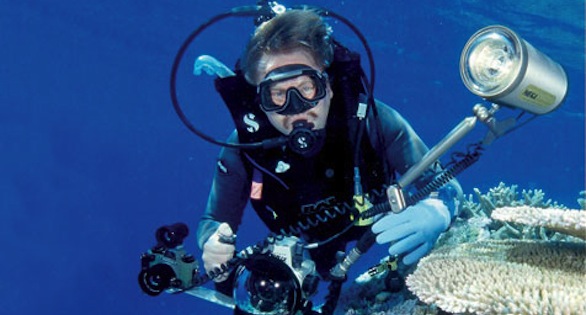
Helmut Debelius with his underwater cameras on a reef in the South Seas state of Tuvalu, north of Fiji, in 2001.
CORAL: Ichthyologist Dr. John E. Randall has been your mentor, teaching you the scientific tools of your trade. How did you get to know him, and what did this contact signify for your future course?
Helmut Debelius: Within a year of my first visit, Rodney again invited me to Sri Lanka, and, armed with my own SLR camera in an Ikelite housing and a homemade flash housing, I was soon on the photographic hunt for the Blue-ring Angelfish that so fascinated me. I now even got to know the coast around Trincomalee in the east of the country, which soon afterwards became inaccessible for decades due to the war with the Tamils.
Ichthyologist Jack Randall from Hawaii was visiting Rodney, and I offered myself as his collecting assistant. I will never forget the evenings in the hotel, when Jack instructed me in ichthyology and answered all my questions. But something even better came next: Jack was planning to collect fishes in the Maldives immediately after his stay in Sri Lanka. And so soon I was sitting among smelly oil containers in a Singhalese military plane, in order to be shaken to bits on the bumpy landing strip on Little Hulule. The fuel for the return flight had to travel with us so that the little plane could fly home again. In those days there were just two resorts on North Male Atoll offering bungalows for tourists and travelers.
How much lovelier the reefs were here in comparison to Sri Lanka! Through the crystal-clear water I could see from afar not only the splendor of the corals but also the vast shoals of fishes on the home reef at Vilingili. The photographic opportunities really began to enthrall me! In addition I learned a lot about the taxonomy of the fishes by looking over Jack’s shoulder and counting fin-rays and scales for myself.
CORAL: At what point did you change from diligent student to independent researcher?
Helmut Debelius: Through Jack Randall I was rapidly in direct contact with the Ichthyology Section at the Senckenberg Research Institute in Frankfurt, where I gobbled up everything I could find on fishes and reefs. Professor Klausewitz, the Curator of Fishes back then, was most enthusiastic when he heard about my plans for my next trip, to the Cape Verde Islands, and he asked me to please bring back endemic fishes for the Senckenberg collection. It was a very exciting undertaking, from which I also brought back uncommon species alive in my luggage for the aquaria I had by now set up for myself. From this time on I began to write for the aquarium-hobby press as well as a dive magazine.
CORAL: The story goes that in the 1970s your main job was as a bodyguard. That sounds rather bizarre for a journalist.
Helmut Debelius: In those days I was working mainly as a detective. Through a job advert I learned of the small, elite group of bodyguards who protected German diplomats, who in those days were at threat from the “Red Army Fraction” (“RAF”) and their foreign sympathizers. I eagerly scanned the list of vacancies at the Foreign Office and simultaneously calculated the distance to the nearest tropical reef. No sooner said than done: in 1977 I went to Jordan as personal bodyguard to the German Ambassador, and from then on spent every free moment in the Gulf of Aqaba. During this period, in the course of which I became versed in the flowery Arabian language, I acquired the name “Abu el Samak”—father of fishes.
My publications increasingly required photos of marine creatures that I had not yet been able to photograph underwater. So I made a virtue of necessity and, whenever I could, made contact with the great underwater photographers of the world. At that time the best of these came from the USA or Australia. Thus while diving in the kelp forests of California, I met the subsequently world-famous photographers and underwater film cameramen Howard Hall, Jack McKenney, and Al Giddings.
Moreover, as hardly any photographer is able to market his photos directly worldwide, what I was offering met with great interest. The IKAN underwater photographic archive was born and officially announced in October 1979.
In 1983 my first book, Armored Knights of the Sea, about ornamental shrimps, was published, and the specialized marine habitat photo archive was well received. In the same year a scientist named the shrimp Lysmata debelius after me, and thanks to that my name became known to practically every aquarist. Following on from providing just photos, I next also offered so-called “menus,” that is complete articles with text and photos. Thanks to extensive photo spreads by friends such as Howard Hall, Chris Newbert, and Rudie Kuiter, for which I wrote the text, I sometimes filled 10–20 pages in the publications Stern and Paris Match.
The IKAN underwater archive proved particularly useful when, in 1988, Heinz Ritter started his journal UWF dealing with underwater photography, as numerous IKAN photo spreads contributed to the success of the magazine. My more recent book projects are probably well-known to your readers—in the final analysis my “fish guides” as well as the Atlas of Marine Fishes sit in the bookcases of innumerable divers, aquarists, and other enthusiasts.
CORAL: To make it official—this year you are retiring completely from active work as a photographer, author, and publisher. Why are you taking this step, after such an active career? Are you going because it seems to be the best time to do so?
Helmut Debelius: It is true that I am giving up active authorship and the work with the IKAN archive this year, and it was certainly not an easy decision to take. In particular my collaboration with Rudie Kuiter from Melbourne, himself self-taught, has given me a lot of pleasure and unexpected success over many years.
It was in 2003 that the idea came to us, over a glass of red wine, of cataloguing the world of marine creatures in two monumental lexicons. With several thousand species, and photos of the most popular—with aquarists and divers—fishes and invertebrates from all the seas of the Earth, it would be a real milestone. There would also be an American fish lexicon with some 1,800 species. What an undertaking!
It was obvious to us that such an enterprise wouldn’t be possible using our own photos alone. We informed friends and colleagues, and the idea was met with great enthusiasm. Nevertheless we had no idea what the project would cost us in terms of time and stress. In 2006 the World Atlas of Marine Fishes was published in three languages and became a bestseller despite (or thanks to) its scope—some 730 pages and more than 6,000 underwater photos. In the same year we began work on the second Atlas(gastropods, worms, echinoderms, and crustaceans), but soon realized that the envisaged groups would not fit onto the planned 730 pages. As great fans of gastropods we decided to publish a separate work, Nudibranchs and Sea Snails, in the same format but with a smaller number of pages, and did so in 2007. Only then followed the work on the invertebrate book proper. Given the need to write a book for laymen but to nevertheless publish something that was scientifically correct, we initially had a number of problems. Nevertheless, the Atlas of Invertebrate Marine Organisms was published in summer 2009, and Rudie and I are very proud of the result.
This monumental work is my very last book as author, editor, and publisher. Why? Well, there have been 22 books since the founding of the IKAN underwater photographic archive and then the publishing company in 1979, and after 30 years of labor-intensive observation, research, discovery, and writing about the marine habitat, the time has come to take things a little easier….
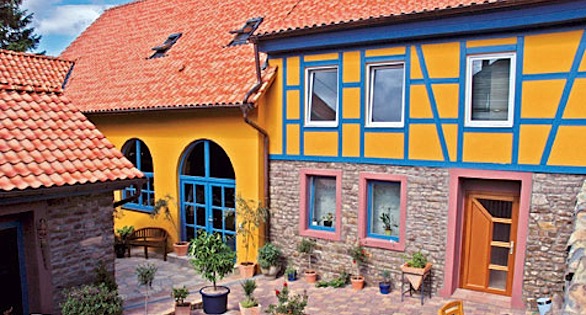
The home of the grape-grower Debelius: the colors of the Villa IKAN (neon blue and yellow ochre) echo those of the Blue-Ring Angelfish (Pomacanthus annularis).
CORAL: What activities can we still expect of you after 30 years of IKAN?
Helmut Debelius: During the production of my series of books since 1993 I have no longer had time to give lectures. I now propose to remedy that and sign my books at the same time. I have also accepted an offer from a cruise company, which will involve my lecturing to the passengers about the underwater world once a year.
CORAL: We know you have two additional interests that may come as a surprise to your many readers. Could you please tell us more about these?
Helmut Debelius: Gladly. Clarification is more necessary than previously in an age where religious Creationism has invaded our society. As an evolutionary naturalist I have joined the Giordano Bruno Foundation, a humanist think tank whose goal is to develop a viable secular alternative to the existing religions and to assist its social breakthrough. I respect Charles Darwin and his evolutionary teachings.
As for the other interest that you mention: after 35 years in Frankfurt am Main I moved to Rheinhessen, bought a vineyard, and am now producing a delicious white Riesling and more recently a red Regent as well.
CORAL: Helmut, thank you very much for this conversation.
Photographs: Courtesy Helmut Debelius. Copyright © IKAN. All rights reserved.
